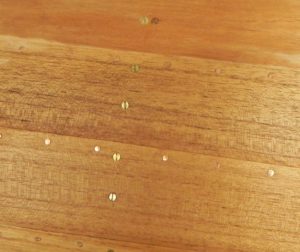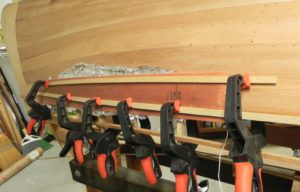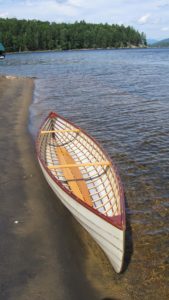I expected the seventh round of planking to be easier than those before it. It was not to be. This time I almost gave up. The challenges seemed insurmountable.
I need to start by reviewing the wood I am using. I am using Spanish cedar. As I tell everyone who will listen, Spanish cedar isn’t Spanish nor is it cedar. It originates in Central America and is a relative of mahagony. It is light weight and is extremely attractive when finished.
The early guideboat builders used white pine when planking their boats. The reason for their choice of white pine was that it was plentiful in the Adirondacks. I have come to realize that the builders could also get a desirable cut from white pine logs called quarter sawn. With quarter sawn planks the grain runs parallel to the long edge of the plank. I believe that the early builders also recognized that quarter sawn stock had an advantage when planking a guideboat. It was more pliable when they needed it to conform to the curve of the hull. With the other cut, flat sawn, each growth ring is stacked one on top of another like a deck of cards. It is very stiff when it comes to trying to make it conform to the hull shape. See the diagrams of flat and quarter sawn planks below. They were taken from my book Tale of an Historic Guideboat and How to Build One.

Spanish cedar comes in wide planks that are mostly flat sawn. You really have no choice when you select it at the hardwood purveyor. One benefit of flat sawn is that it is a lovely cut of wood, much more attractive than quarter sawn.
Here is a photo of flat sawn Spanish cedar on my boat. I enhanced it using mineral spirits. The application of spar varnish will also bring out the lovely appearance of this wood.

With the seventh round I was having trouble matching the feather edge of each new plank with the previous one. I couldn’t close the gap between the fresh plank and the previous one. After scratching my head I came to find out that there was a gap, as much as 1/4″ between the previously installed plank and some of its ribs. This will never do. But how to correct it? I couldn’t remove and redo the previous plank. ( I could but let’s not go there)
I took a long step back and thought about how to make it right. We talked earlier about the dance wood plays with moisture. As I mentioned in a previous blog, wood can be coaxed to bend in different shapes when “steamed” or held at an elevated temperature in an environment saturated with moisture (steam). You might also remember that I use a technique I call “flash molding” to bend my planks so they conform to the ribs. The flash molding process is as follows: The plank is sprayed with water on each side and wrapped in aluminum foil. A thermal heating blanket is placed on the outside and the “sandwich” is clamped in its place next to the previous plank. The thermal blanket is turned on and the temperature raised to 300 degrees F. Once it reaches that temperature, the bottom, free side, is clamped down.To eliminate spring back I put small shims under each plank before performing flash molding.
In the present case the plank was already fixed in place on its top side. So I sprayed the outside of the plank with water and applied the aluminum foil to the outside only. Before all this I put the shims between each rib and plank midway down the rib. Then I clamped the thermal blanket in place and heated it all up. Here is a view of that going on.

It worked!
The plank now conformed perfectly to each rib. Phew!
Some lessons I have learned about the cut of wood and how easily it can be made to conform to the shape you want it to assume. I have built a number of lightweight canoes called Aerolite canoes by their inventor, Platt Monfort, of Maine. The ribs are of ash and must be bent to the shape of the hull. They are are probably 1/8″ thick by 1/2″ wide. I found that they must be of flat sawn ash. To shape them I first soak them for about a week in water and then submerge them in a pan of water as hot as I can get it. This causes them to become as flexible as wet noodles. I clamp them in place and let them dry. They take the shape I want beautifully.
Here is one of the Aerolite canoes I built.

I had a terrible time getting a cherry gunwale to conform to the hull of the guideboats I was building. I had to set up a crude steaming tent and winch the gunwale in place. Then someone told me to use quarter sawn, not flat sawn, cherry for the gunwales. Sure enough it made a terrific difference.
So wood is nothing more than a composite material. Each spring and summer there is a growth spurt as the tree grows outward. As fall approaches, growth slows and ends. Where it ends the ring of growth forms a harder shell. This leaves the inner, faster growing part of the growth ring as being more pliable then the harder, outer shell. So, this means that with quarter sawn planks it is easier to bend them across the shorter part of the plank. With flat sawn wood it is just the opposite. It bends more easily along the length of the plank.
Now I am on the final leg of my planking journey. Round eight is the last round! This means I must confront snye. Do you remember the word snye? We will talk about it next time.